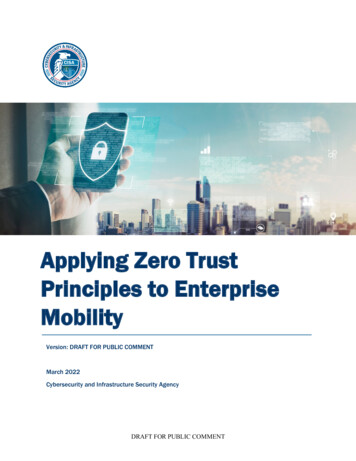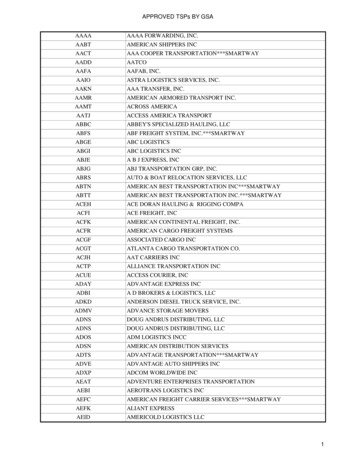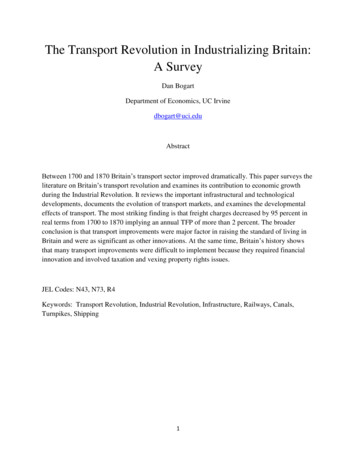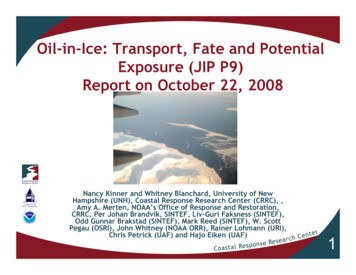
Transcription
Vision Zero action planTaking forward the Mayor's Transport Strategy
About Transport for London (TfL)Part of the Greater London Authorityfamily led by Mayor of London SadiqKhan, we are the integrated transportauthority responsible for delivering theMayor’s aims for transport.We have a key role in shaping whatlife is like in London, helping to realisethe Mayor’s vision for a ‘City for AllLondoners’. We are committed tocreating a fairer, greener, healthier andmore prosperous city. The Mayor’sTransport Strategy sets a target for 80per cent of all journeys to be made onfoot, by cycle or using public transportby 2041. To make this a reality, weprioritise health and the quality ofpeople’s experience in everything we do.We manage the city’s red routestrategic roads and, throughcollaboration with the London boroughs,can help shape the character of allLondon’s streets. These are the placeswhere Londoners travel, work, shop andsocialise. Making them places for peopleto walk, cycle and spend time will reducecar dependency and improve air quality,revitalise town centres, boost businessesand connect communities.We run most of London’s publictransport services, including theLondon Underground, London Buses,the Docklands Light Railway, LondonOverground, TfL Rail, London Trams,London River Services, London Dial-aRide, Victoria Coach Station, SantanderCycles and the Emirates Air Line. Thequality and accessibility of these servicesis fundamental to Londoners’ qualityof life. By improving and expandingpublic transport, we can make people’slives easier and increase the appeal ofsustainable travel over private car use.We are moving ahead with many ofLondon’s most significant infrastructureprojects, using transport to unlock growth.We are working with partners on majorprojects like Crossrail 2 and the Bakerlooline extension that will deliver the newhomes and jobs London and the UK need.We are in the final phases of completingthe Elizabeth line which, when it opens, willadd 10 per cent to London’s rail capacity.Supporting the delivery of high-density,mixed-use developments that areplanned around active and sustainabletravel will ensure that London’s growth isgood growth. We also use our own landto provide thousands of new affordablehomes and our own supply chaincreates tens of thousands of jobs andapprenticeships across the country.We are committed to being an employerthat is fully representative of thecommunity we serve, where everyonecan realise their potential. Our aim is tobe a fully inclusive employer, valuing andcelebrating the diversity of our workforceto improve services for all Londoners.We are constantly working to improvethe city for everyone. This meansfreezing TfL fares so everyone can affordto use public transport, using data andtechnology to make services intuitive andeasy to use, and doing all we can to makestreets and transport services accessibleto all. We reinvest every penny of ourincome to continually improve transportnetworks for the people who use themevery day.None of this would be possible withoutthe support of boroughs, communitiesand other partners who we work with toimprove our services. We all need to pulltogether to deliver the Mayor’s TransportStrategy; by doing so we can create abetter city as London grows.Contents4Forewords8Chapter 1 – Vision Zero for London24 Chapter 2 – Steps towards the VisionZero ambition28Chapter 3 – Safe speeds46Chapter 4 – Safe streets56Chapter 5 – Safe vehicles78Chapter 6 – Safe behaviours94 Chapter 7 – Post-collision learning andcriminal justice98 Chapter 8 – Road danger reduction:continuing the journey104 A nnex A: New powers needed toreduce road danger
4ForewordVision Zero action planMayor’s forewordEvery year more than 2,000 people arekilled or seriously injured on London’sstreets. People from more deprivedareas, some ethnic minorities, disabledpeople, children and older peopleare disproportionately affected byroad danger. I am determined to makeLondon’s streets safer and reduce theseroad traffic injury inequalities.Our Transport Strategy sets outa big, bold aim for 80 per centof all journeys in London to beconducted by walking, cyclingor using public transport by 2041For too long these tragic road incidentshave been accepted as inevitable events.This would be unthinkable on othertransport modes. We must change thismindset and City Hall has been workingwith Transport for London and theMetropolitan Police Service to ensurethat human health and wellbeing areat the heart of how we think aboutLondon’s road network.Our Transport Strategy sets out a big,bold aim for 80 per cent of all journeysin London to be made by walking, cyclingor using public transport by 2041. Thiscan only be achieved by tackling thedangers that can result in road collisions,with lives tragically lost, serious injuriessustained, and the fear of these dangersthat discourages the use of these moreactive, sustainable and efficient modesof travel. Our Vision Zero ambition – theelimination of all deaths and seriousinjuries from London’s streets by 2041 –will see a radical change to how Londonapproaches road danger. We will focuson reducing the dominance of motorvehicles on our streets and ensuring thatroad danger reduction is central to alltransport-related activity.Lowering speeds is one of the mostimportant things that we can do tomake our streets safer. This is because aperson is about five times less likely tobe fatally injured if hit at 20mph than at30mph. We have developed a progressivespeed limit policy for the Transport forLondon Road Network, which will seeus engaging on 20mph becoming thedefault speed limit within the centralLondon Congestion Charging zone and inother locations and town centres acrossLondon. This means that almost onethird of our strategic road network willbenefit from lower, safer, speed limits.We will continue to deliver majorsafety improvements at London’s mostdangerous junctions and deliver the nextgeneration of high-quality cycle routes.Later this year, we will be introducing aworld-leading Bus Safety Standard forthe city’s entire bus fleet, which willensure that only the safest buses aredriven on London’s streets. In 2020 theworld’s first Direct Vision Standard forHGVs will come into effect which willfundamentally improve the safety ofHGVs in London.Realising Vision Zero will requirecoordinated action at all levels. Ninetyfive per cent of London’s streets are theresponsibility of boroughs and thereare many other partners who we willneed to work with including centralGovernment, the health sector, vehiclemanufacturers and many more, to createa safer city. I urge everyone involved inmanaging and using London’s streets tojoin us in our efforts to end the toll ofdeaths and serious injuries.Sadiq KhanMayor of London5
6ForewordVision Zero action planForewordForewordThis action plan focuses particularly onreducing road danger on our network,because people are much more at riskof injury when travelling on our streetsthan they are when travelling by rail orthe Underground. This plan outlines theimportant first stages in a wide-rangingprogramme of actions that we are takingnow and over the coming years.It is neither inevitable nor acceptablethat anyone should be killed or seriouslyinjured when travelling in London.When we leave our homes each day,we should feel safe and confident aboutthe journey ahead.All of us, whether we are travelling inLondon or helping people make theirjourneys, share a responsibility and amoral imperative to reduce danger andthe fear it creates. My first priority is thesafety of everyone using and working onour transport network. I want to fostera culture where everyone, no matterwhat their role, is encouraged to makea real contribution to eliminate danger.By including the reduction of injuries tocustomers and our workforce on ourScorecard, we will ensure a continuousfocus on our Vision Zero targets andambition.For progress to be made we needto work in close partnership withLondon boroughs, the police and otheragencies in London, as well as theUK Government. Together, with onecommon vision, we will continue toshare ideas and develop plans to makeLondon’s streets safer and feel safer.Mike Brown MVOCommissioner of TransportOur Roads and Transport PolicingCommand, part funded by Transportfor London, is the UK’s single largestpolicing command and is dedicated toensuring all journeys across the roadand surface transport network are safe,secure and reliable. The Command haslead policing responsibility for roaddanger reduction in London and focusesits efforts on tackling the vehicles,drivers and road user behaviour thatcause the greatest risk on the roads.Last year, 132 people died on London’sroads. Their families and friends wereleft devastated; lives changed forever.Every death on our roads is tragicand unacceptable. Despite significantprogress to reduce harm on London’sroads over the last decade, more canand must be done. The police andall those with a responsibility formanaging, operating and enforcingLondon’s roads must be relentless inour combined efforts to reduce roaddanger and protect Londoners fromharm. This Vision Zero action plansets out the greater level of ambitionand the commitment demanded fromall partnership agencies involved inreducing road danger in London. As thebiggest police force in London, we havea significant contribution to make tokeeping our roads and communities safeand secure.London benefits from the uniquepartnership between the MetropolitanPolice Service and Transport forLondon. The range and scale of Roadsand Transport Policing Command’sroad danger reduction policing andenforcement activity is unparalleled.In line with the Mayor’s Vision Zerocommitment we are enhancing ourapproach and intensifying our effortsto reduce road danger. I am committedto making London’s roads safer and willensure that the Metropolitan PoliceService plays a full part in achievingVision Zero.Cressida DickCommissioner of the MetropolitanPolice Service7
8Vision Zero action planVision Zero for LondonChapter 1 – Vision Zerofor London1.1 London’s commitment to Vision ZeroMajor cities around the world are takinga stand to end the toll of deaths andinjury seen on their roads. London is atthe forefront of this and the Mayor’sTransport Strategy sets out the goalthat, by 2041, all deaths and seriousinjuries will be eliminated from London’stransport network.Systematic action must be taken toachieve this goal, known as Vision Zero.The tram overturning at Sandilands inCroydon in 2016 showed that seriousincidents with tragic consequences canoccur on public transport systems. TheMayor is committed to making sureLondoners can travel safely throughoutthe entire transport system. All parts ofthe public transport network will play animportant role in achieving Vision Zero.Investment in new infrastructure andservice enhancements, as well as otherfactors such as staff training, will helpmake public transport even safer andmore secure.While work continues to make ourwider transport network even safer, thisaction plan focuses specifically on theareas where our greatest challenges lie– London’s streets. It will demonstrateto everyone who uses our streets,stakeholders and other cities thecommitment of the Mayor, TfL, Londonboroughs, the police and other partnersto taking bold action and putting theVision Zero ambition at the heart ofeverything we do.The Vision Zero ambition is set outin Policy 3 of the Mayor’s TransportStrategy: The Mayor, through TfL and theboroughs, and working withstakeholders, will adopt VisionZero for road danger in London.The Mayor’s aim is for no oneto be killed in or by a Londonbus by 2030, and for all deathsand serious injuries from roadcollisions to be eliminated fromLondon’s streets by 2041This action plan follows Proposal 10of the Mayor’s Transport Strategy: The Mayor, through TfL and theboroughs, will collaborativelyset out a programme to achievethe Vision Zero aim of reducingthe number of people killed orseriously injured on London’sstreets to zero9
Vision Zero for London10Vision Zero action plan1.2 Progress in tackling London’s road danger11Figure 1: Fatal and serious injury casualties in London7,000London is a dynamic and diverseworld-class city, shaped by itstransport network. This networkenhances Londoners’ lives byconnecting communities, opening upopportunities that can improve healthand quality of life. The network hasbecome substantially safer in recentyears, with significant reductionsin the number of collisions and ofthe number of people being killedor seriously injured as a result: The number of people killed andseriously injured on London’s roadsfell by 31 per cent against a 2005-09baseline by 20161 (table 1) During 2016, the number of fatalitieson London’s roads fell to the lowestlevel on record, with car occupantfatalities halving when comparedto 2015 London has lower rates of fatalinjuries on its streets compared toother international cities such asVancouver, Copenhagen, Barcelonaand Rome that have adopted, or are inthe process of adopting, a Vision Zeroapproach2 The rate of people killed or seriouslyinjured per London resident is lowerthan the comparable national figure.In 2016, there were 285 deaths andserious injuries from road trafficcollisions per million Londonresidents, compared to 401 deathsand serious injuries per million peoplenationally (excluding London) The overall downward trend in deathsand serious injuries can be seen inFigure 1As a result of improved reporting ofinjury severity by the police, moreinjuries are being classified as seriousrather than slight. This means thatfigures for the number of serious injuriesduring 2016 and afterwards are notdirectly comparable with previous 000284020002111162005-092016 Fatal SeriousTable 1: Fatal and serious injury casualties in London by road user3Casualty numbersWe will work with the Department forTransport (DfT) to back-estimate thenumber of seriously injured casualtiesthat would have been reported by thepolice using an injury-defined ratherthan a severity-defined system. This willallow comparisons to be made betweenthe most recent injury figures andprevious years.Figures for road traffic collisions on London’s roads during 2017 have been collected by the police usingnew data systems. This data is being fully validated and will be published at the end of September 20182 Safer City Streets: A Global Road Safety Benchmark — OECD/ITF 20173 Collisions and casualties on London’s Roads, TfL, 20162005-09Percentage changeUser groupGraph data 4875-28%Motorcyclists791.2681-14%Pedal cyclists420.64548%Car occupants949.0368-61%Bus or coach occupants139.670-50%Other vehicle occupants109.853-52%3,626.62,501-31%Total16795,833
12Vision Zero for LondonVision Zero action plan1.3 The challengesDespite progress, considerablechallenges remain. In 2016, more than30,000 people were injured in roadcollisions. Of these, 116 people werekilled, 2,385 were seriously injured and27,769 were slightly injured.In addition, the extent of recentprogress in road casualty reduction isnot seen equally in all areas: People are more at risk whenwalking, cycling or using amotorcycleTravelling by car has now becomemuch safer, partially reflectingimprovements in vehicle safetyfeatures. Today, there is a higher riskwhen travelling by foot, by bicycleand by motorcycle. People killed orseriously injured when travelling bythese modes now account for 80 percent of all deaths and serious injurieson London’s roads (Figure 2). In 2016,over a quarter of all trips were madeon foot or by bicycle,4 but in the sameyear, people walking and cycling madeup 53 per cent of those killed andseriously injured on our roads Some vehicles pose a greaterdanger than othersThe majority of pedestrian casualties(of all severities) involve a car, butthose involving HGVs and buses aredisproportionately likely to result infatality. Of the 69 pedestrians andcyclists killed in London in 2016, 27were involved in a collision with anHGV or a bus.5 For motorcyclists, itwas five out of a total of 33 fatalities.The severity of these collisionsincreases significantly the faster thevehicle is moving Almost three quarters of fatal andserious injury collisions in Londonoccur at junctions (see Figure 3 onpage 17)Junctions are particularly dangerousfor people riding bicycles andmotorcycles. In 2015, the manoeuvresmost likely to result in a cyclistbeing killed or seriously injured werewhen another vehicle turned leftor right across their path. Similarly,for motorcyclists, other vehiclesturning right across their path was themanoeuvre most likely to result inthem being killed or seriously injured64 Travel in London Report 10, TfL 20175 Collisions and casualties on London’s Roads, TfL, 20166 Collisions and casualties on London’s Roads, TfL, 2015Figure 2: Overall reduction in collisions resulting in death and serious 791.2420.63681,216.4020002005-09 Pedestrians Pedal cyclist Motorcyclists Car occupants Bus or coach occupants Other vehicle occupantsPeople walking, cycling and ridingmotorcycles now account for a greaterproportion of casualties (Figure 2).2,5016814548752016/177013
14Vision Zero for London Human error contributes toaround 90 per cent of all collisionsin LondonChief among these contributoryfactors are travelling at inappropriatespeed and making risky manoeuvres.7Tackling these behaviours isprioritised in this action plan People are more at risk per journeywhen walking and cycling in outerLondon than in central LondonRisk varies between boroughs andmany have had success in reducingrisk. There is a greater concentrationof collisions resulting in death orserious injury in central and innerLondon, corresponding to thegreater density of traffic and people.However, while the absolute numbersof injuries among people who walk,cycle and use motorcycles are highestin inner London, those in outerLondon boroughs are at most risk perkilometre travelled8 People from more deprived areas,some ethnic minorities, disabledpeople, children and older peopleexperience the worst impacts ofroad danger, noise and air pollutionMain roads pass through some of themost deprived communities, creatingenvironments that are not inclusiveto all, with roads that are intimidatingand difficult to cross. People walkingVision Zero action planin the most deprived areas of Londonare more than twice as likely to beinjured as those in the least deprivedareas. People aged between 20 and 29years old are more likely to be killedor seriously injured than other agegroups and the number of childrenkilled or seriously injured in carsincreased in 2016. BAME Londonersare more at risk, with children in thisgroup being on average 1.5 times aslikely to be killed or seriously injured onthe roads than non-BAME children9 Without action, inequality couldget worse as the population growsWith a population of 8.7 million,London is now larger than it hasever been and it is forecast to growto 10.8 million by 2041. This growthis expected to generate more thansix million additional trips each day.To accommodate these trips, morejourneys will need to be taken on foot,by bicycle or on public transport, themost efficient modes of transport.London’s population is also livinglonger, which means there will be agreater proportion of older peoplewho are less able to cope with thephysical impact of collisions. Thesechanges in London’s population meanit is even more vital, and yet morechallenging, to tackle road danger7 Data analysis of STATS19 dataset (MPS, 2014-2016)8 Data analysis of STATS19 dataset (MPS, 2014-2016) and London Travel Demand Survey(TfL, 2013/14 to 2015/16)9 Data analysis of STATS19 dataset (MPS, 2012-2016)80%of all deaths and seriousinjuries occur to peoplewalking, cycling or ridingmotorcycles20-29year-olds are more likely to bekilled or seriously injured thanother age groupsThere was an increase inthe number of children killedor injured as car passengersin 201669pedestrians and cyclists killedin London in 2016, 27 wereinvolved in a collision with anHGV or a bus15
16Vision Zero for LondonVision Zero action planLondoners face an even greaterchallenge to their health and wellbeingthan that posed by traffic collisions.Lack of physical activity in our daily livesis now one of the biggest threats to ourhealth, increasing the risk of developinga range of chronic diseases includingdiabetes, dementia, depression and thetwo biggest killers in London – heartdisease and cancer.In light of these challenges and usinginformation from the long-term casualtytrends and perceptions of safety, weneed to address the key sources ofroad danger and the fear they inspire.In particular:We urgently need to design physicalactivity back into our everyday lives.Active travel – walking more, cyclingmore, using public transport more –provides the easiest and most affordableway for us all to get more active and livehealthier lives. Focusing action on the most dangerouslocations, particularly junctionsRoad danger is a significant barrier toactive travel: The main deterrent to people takingup cycling, cycling more often, orbeing willing to let their children walkor cycle unaccompanied in London,is the fear of traffic collisions10Figure 3: Location of collisions resulting in death or serious injury(2014 to 2016)Multi-junction(1%) Reducing the likelihood andseverity of collisions by loweringvehicle speedsUnknown(0.5%)Slip road(1%) Reducing the danger posed bythe vehicles with the greatest risk:HGVs, buses, taxis and privatehire vehicles Reducing danger for people whenthey are most at risk – when walking,cycling or riding a motorcycle17Mini-roundabout(2%)Other junction(2%)Private driveway(2.5%)Roundabout(3%)Nojunctionwithin20 metresCrossroads(15%)(28%) Improved safety is also cited byLondoners as one of the mainmotivators for walking more11‘T’/staggered junction(45%)10 Attitudes to Cycling, TfL, 201611 Attitudes to Walking, TfL, 2014
18Vision Zero for LondonFigure 4: 10 Healthy Streets IndicatorsVision Zero action plan1.4 Addressing the challenges – a new approachto reducing road dangerThe scale of these challenges requiresa step-change in the approach that wetake to reducing road danger in London.Central to this are three guiding principles:2. The Vision Zero approach requiresreducing the dominance of motorvehicles and creating streets safefor active travel1. The Vision Zero approach is based onthe fundamental conviction that lossof life and serious injuries are neitheracceptable nor inevitableThe Vision Zero ambition is inextricablylinked to the Healthy Streets Approach,which puts human health and experienceat the heart of city planning. Reducingthe dominance and overall numbers ofthe most dangerous vehicles is centralto the Healthy Streets Approach and toachieving Vision Zero, and will reduceLondoners’ exposure to road danger.By making our streets safer and feelsafer, we will create streets wherepeople want to walk, cycle and usepublic transport. This is why ‘peoplefeel safe’ is one of the Healthy StreetsIndicators (see Figure 4).An incident that results in an injury issometimes referred to as an ‘accident’,a word that implies that there is nocause and that it is therefore inevitable.While there has been great success inmeeting previous targets for reducingthe number of people killed andseriously injured, no death or seriousinjury is acceptable, so the ultimateaim must be zero. There are more than2,000 deaths and serious injuries on ournetwork each year, which makes this anurgent public health issue, and one thateveryone managing and using London’sstreets has an obligation to tackle.Source: Lucy Saunders19
20Vision Zero for LondonThe Mayor’s Transport Strategy sets outpolicies and proposals to promote a shiftaway from journeys by car to walking,cycling and public transport. These aimto reduce motorised traffic in London by10-15 per cent by 2041. This means threemillion fewer car trips on London’s roadseach day. This will help people feel saferand be more likely to walk and cycle,which will in turn help to reduce caruse further.This action plan sets out specificactions to tackle the sources of roaddanger, but success will also depend onimplementation of the wider aims ofthe Mayor’s Transport Strategy to createa safer city that is less dominated bymotor vehicles.Vision Zero action plan3. The Vision Zero approach ensuresroad danger reduction is a commonpriority for TfL, boroughs, and roadspolicingThe shift in emphasis from tacklinghistoric casualty trends, to a proactiveapproach of targeting road danger,presents an opportunity to set roaddanger reduction within a broadercontext. Addressing the inherent dangeron London’s roads will help create moreforgiving, welcoming streets that feelsafer, making walking and cycling a moreattractive option. Casualty reductionwill follow as risk is reduced, andlocations where there have been fewcasualties but where people feel unsafe,will perform better across the HealthyStreets Indicators.Figure 5: Road danger reduction as part of the Healthy Streets ApproachReducedominanceof motortrafficReducedanger, fewercasualties,people feelsafeMode shiftaway fromprivatevehiclesPeople feelconfident towalk, cycle anduse publictransport21
22Vision Zero for LondonVision Zero action plan1.5 Road danger reduction targetsThe road danger reduction targets to drive action towards Vision Zero are:The Mayor’s Transport Strategy includestargets to drive action and set thenecessary trajectory towards the VisionZero ambition of zero deaths and seriousinjuries from road collisions. Thesetargets are for the whole of London, andtherefore responsibility for achievingthem is shared.By 2022London boroughs are required to settheir own casualty reduction targets thatalign with these targets, while reflectingthe specific mode share, demographicand historic casualty reductionperformance particular to each area.Specific targets have been set forLondon buses to demonstrate that wewill lead the way with the vehicles overwhich we have the greatest operationaland contractual control.65% fewer people killed or seriouslyinjured against 2005-09 levels70% fewer people killed or seriouslyinjured in, or by, London busesagainst 2005-09 levelsBy 203070% fewer people killed or seriouslyinjured against 2010-14 levels0people killed in, or by, London buses23
24Steps towards the Vision Zero ambitionVision Zero action planChapter 2 – Steps towardsthe Vision Zero ambition2.1 A Safe System approachOur programme of action takes a SafeSystem approach, an internationallyrecognised approach to road dangerreduction. The programme is designedto take account of these Safe Systemprinciples:1. People make mistakes, so ourtransport system needs toaccommodate human error andunpredictability2. There are physical limits to whatthe human body can tolerate. Ourtransport system needs to beforgiving, so that the impact of acollision is not sufficient to causefatal or serious injury3. All those with a role in designing,building, operating, managing andusing our streets have a responsibilityto reduce dangerAll parts of the system must bestrengthened in combination to multiplytheir effects, so that people are stillprotected if one part fails.25
26Steps towards the Vision Zero ambitionVision Zero action plan2.2 The programme of actionIn addition to the principles of the SafeSystem approach, the programme alsoemploys a framework of interventionsaround five pillars of action:Chapter 3Safe speedsencouraging speeds appropriate tothe street Safe speedsChapter 4Safe streetsdesigning an environment forgivingof mistakes Safe streets Safe vehicles Safe behaviours Post-collision responseThese five pillars cover themes ofactivity that closely match the keychallenges identified in the previouschapter. The purpose of categorisingactivity in these themes is to supporta more holistic approach to deliverywhich recognises that all parts of the‘system’ need to work in combination.The Safe System themes are in order ofthe potential for long-term reductionsin road danger and the greaterresponsibility of the ‘system designer’over the ‘system user’.The following chapters outlinecomprehensive, evidence-basedactions that will be taken to reducedanger on London’s streets and worktowards Vision Zero. The actions aregrouped according to the SafeSystems framework:Chapter 5Safe vehiclesreducing risk posed by the mostdangerous vehiclesChapter 6Safe behavioursimproving the behaviours of peopleusing our roadsChapter 7Post-collision responselearning from collisions and improvingjustice and care for victimsChapter 8Road danger reduction: continuingthe journeyoutlines the need to prepare for achanging world and how we can adaptto deliver Vision Zero beyond 2022The opportunities for the UKGovernment to help enable Vision Zero,through new regulation and guidance,are outlined in Annex A.27
28Safe speedsVision Zero action planChapter 3 – Safe speedsLondon needs streets where the speed at which peopletravel does not endanger others. Lowering traffic speedswill also make our streets more inviting, less polluted,less dominated by motor vehicles and more attractive forwalking and cycling.3.1 The importance of taking action to reduce speedsThe speed at which people are drivingor riding is the single most importantdeterminant of both the likelihood ofa collision occurring and the severityof the outcome. The faster a personis driving, the less time they have toreact to avoid a collision, and the moresevere any resulting injuries will be.The impact of a collision increasesdisproportionately as vehicle speedincreases (Figure 6). If a pedestrian is hitby a vehicle at 20mph, they are aboutfive times less likely to be killed thanif they were hit at 30m
benefit from lower, safer, speed limits. We will continue to deliver major safety improvements at London's most dangerous junctions and deliver the next generation of high-quality cycle routes. . The Vision Zero ambition is set out in Policy 3 of the Mayor's Transport Strategy: The Mayor, through TfL and the boroughs, and working with










